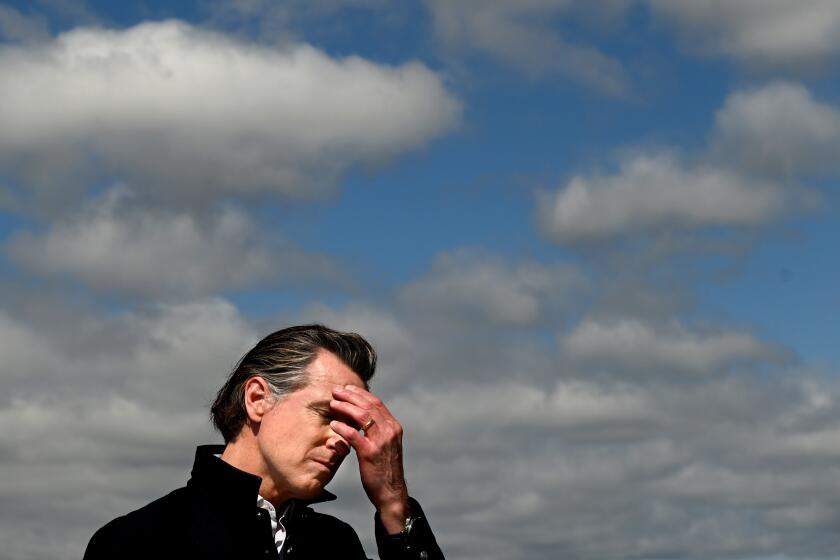The Supreme Court’s Jesus jones
- Share via
A First Amendment argument in the U.S. Supreme Court on Monday was memorable not only because it involved the trippy slogan “Bong Hits 4 Jesus,” nor because it exposed differences between President Bush’s two appointees to the court.
In probing whether an Alaska school district was wrong to suspend Joseph Frederick for unfurling his “bong” banner during an Olympic torch procession, the justices revealed just how conflicted Americans are about the institution of the public school.
The issue in the bong banner case was whether the court would reaffirm, cut back on or finesse a 1969 ruling in which it proclaimed that schoolchildren don’t “shed their constitutional rights to freedom of speech or expression at the schoolhouse gate.” The little litigants in that case, Tinker v. Des Moines School District, were liberal kids who got suspended for wearing black armbands to protest the Vietnam War.
In Tinker, Justice Abe Fortas quickly disposed of the argument that the armbands disrupted the school routine. He was more interested in laying on the First Amendment rhetoric like ketchup.
“In order for the State in the person of school officials to justify prohibition of a particular expression of opinion,” Fortas thundered, “it must be able to show that its action was caused by something more than a mere desire to avoid the discomfort and unpleasantness that always accompany an unpopular viewpoint.”
The key words here are “the State in the person of the school.” Fortas was a New Deal Democrat and crony of Lyndon B. Johnson, who appointed him and unsuccessfully tried to promote him to chief justice. But his reference to the (capital-S) State has a distinctly libertarian ring. That building with the blackboards may call itself a school, but it’s really the state. And, according to a long line of First Amendment decisions, the state may not engage in what the court calls “viewpoint discrimination.”
This is quite a different vision of public schools than one finds in another landmark Supreme Court decision, Brown v. Board of Education. In holding in 1954 that racially segregated public schools were unconstitutional, Chief Justice Earl Warren rhapsodized about the public school’s role as “the very foundation of good citizenship” and “a principal instrument in awakening the child to cultural values.”
Chief Justice John Roberts channeled Warren in one of his questions at the bong argument.
“Where does that notion that our schools have to be content neutral [come from]?” he asked the bong-banner boy’s lawyer. “I thought we wanted our schools to teach something, including something besides just basic elements, including the character formation and not to use drugs. They have to be neutral on whether you should use drugs or not?”
Justice Samuel Alito, proving that he is no Roberts clone, said he found he found “very, very disturbing” the argument that a public school could censor an opinion inconsistent with its educational missionin this case, its mission to discourage drug use.
This comment came as no surprise to those who remembered that Alito, as an appeals court judge, wrote a famous opinion in 2001 (well, famous in legal circles) striking down a Pennsylvania school district policy prohibiting students from harassing each other on the basis of “actual or perceived race, religion, color, national origin, gender, sexual orientation, disability, or other personal characteristics.” (So don’t tease the fat kid!)
The policy had been challenged by two Christian students who worried that it would prevent them from sharing their religious view that homosexuality was sinful.
Earl Warren was a “liberal,” John Roberts is a “conservative,” but they both exalt the public school as a transmitter of values (respectively, tolerance of other races and opposition to drug use). Abe Fortas and Sam Alito, despite their political differences, see the school as a stand-in for the state.
You can find support for both positions not just in Supreme Court decisions but also in attitudes toward public education. Not that combatants in the culture wars don’t sometimes switch sides for tactical reasons.
The bong-banner boy attracted a friend of the court brief from a legal group founded by Pat Robertson, which told the justices that a) they should dismiss the case as “improvidently granted,” but b) if they insisted on addressing the merits, they should rule in favor of the bong dude because of “the larger constitutional principles at stake.”
In the good old days, of course, Christians wouldn’t have to raise the free-speech banner. Prayers and Bible readings were part of the communitarian “cultural values” imparted in the classroom. But if there are no atheists in the foxholes, there are no statists in the trenches of civil-liberties litigation. Christians are now libertarians, and the sinister statists are those agents of the Homosexual Agenda who won’t let Christian kids diss the “gay lifestyle.”
Maybe the lesson is this: Whether we want the schools to be libertarian or communitarian depends on whose values go to the head of the class.
Michael McGough is The Times’ senior editorial writer.
More to Read
A cure for the common opinion
Get thought-provoking perspectives with our weekly newsletter.
You may occasionally receive promotional content from the Los Angeles Times.







